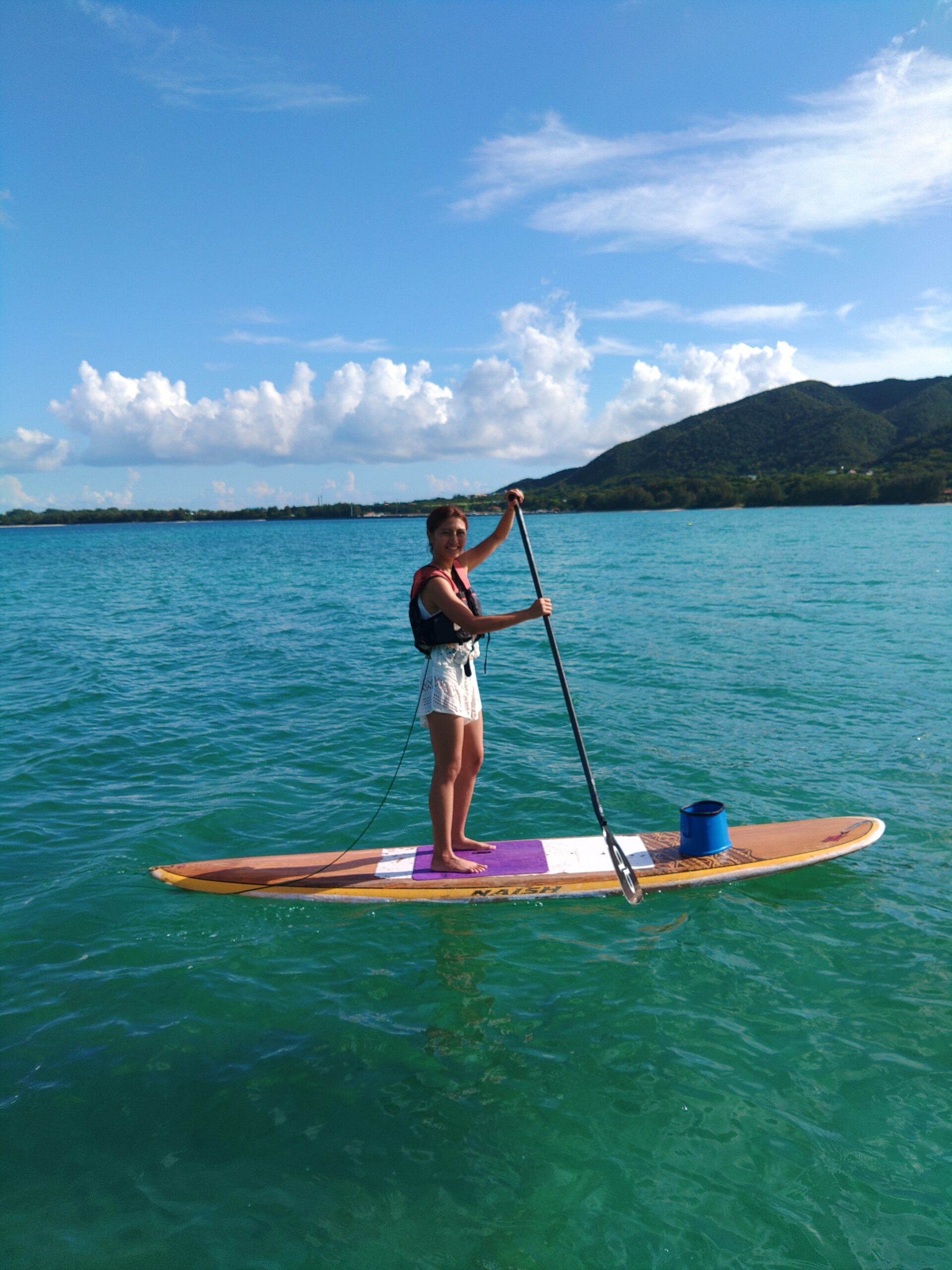










- Stand-Up Paddleboarding (SUP): A Humorous and Stylish Dive into Its History and Evolution
- The Dawn of SUP: A Stroll Through Ancient Waters
- Modern SUP: The Groovy 60s and Radical 70s
- Technological Magic: SUP Boards Get a Makeover
- SUP Takes Over: Global Fame and Competitive Glory
- Sustainable SUP: Paddling Towards a Greener Future
- The Future of SUP: Riding the Waves of Innovation
- Wrapping It Up: The Splendid World of SUP
スタンドアップパドル(SUP)の歴史と発展: 立って漕いで、笑って学ぶ
スタンドアップパドル(SUP)は、水上で漕ぐことで移動するスポーツで、その起源は古代ポリネシア文化にまで遡ります。SUPの魅力は、ただの運動だけではなく、笑いと驚きに満ちたその歴史と発展にあります。今回は、SUPの過去、現在、そして未来について、ユーモアを交えながらスタイリッシュにご紹介します。
歴史の始まり:ポリネシアのスーパーヒーローたち
SUPの始まりは古代ポリネシア文化にありました。想像してみてください、数百年前のハワイで、勇敢な漁師たちが長いボードに立ち、まるでスーパーヒーローのように漕ぎ出していたのです。彼らは魚を捕るために、この方法を活用していました。「立って漕ぐなんて大変そう!」と思うかもしれませんが、彼らにとっては日常茶飯事。これが後に、我々の知るSUPへと進化していきます。
現代の発展:サーフィンのトレーニングからSUPへ
現代の発展:サーフィンのトレーニングからSUPへ
SUPが再び脚光を浴びるのは、1960年代後半から1970年代初頭のハワイでした。当時のサーファーたちは、波のない日でも波乗りの感覚を楽しむために、長いサーフボードに立って漕ぎ出しました。これが現代のSUPの始まりです。その後、1980年代に入ると、ブラジルのサーフィンインストラクターであるジョルジン・カミアーダがSUPをスタンドアップサーフィンとして発展させ、さらに広めました。「スタンドアップサーフィン?」と聞いて、最初は「立ってサーフィン?それって難しそうじゃない?」と笑ってしまった人も多かったでしょうが、実際には大ヒット。
技術革新と普及:軽くて丈夫、そしてクールに
SUPの発展には技術革新が大きく寄与しました。初期のSUPは木製やガラス繊維のボードが主流でしたが、1980年代後半から1990年代にかけて、軽量で丈夫な素材が開発されました。特にポリウレタンやエポキシ樹脂を用いたボードの登場は革命的でした。これにより、ボードはさらに漕ぎやすくなり、トリッキーな波の上でも安定感を保つことができるようになりました。「軽くて丈夫なボード?それって魔法みたいだね!」とSUPファンたちの間で話題になりました。
2000年代に入ると、SUPは急速に普及しました。湖や川、海など、あらゆる水域で楽しめることが大きな魅力です。「SUPで川を漕ぐなんて、まるで探検家みたい!」と感じる人も多かったことでしょう。また、フィットネスやリラクゼーションの手段としても注目され、一般の人々にも広く受け入れられました。
グローバルな人気と競技化:世界が舞台のSUPレース
SUPは世界的に人気を博し、多くの国で競技化されています。2007年にはアメリカのレイクタホで最初の国際的なSUPレースが開催されました。これをきっかけに世界中でレースイベントが増加しました。「SUPレース?なんてクールなんだ!」と興奮した人々が集まり、競技は大いに盛り上がりました。2013年には、国際サーフィン連盟(ISA)がSUPのワールドチャンピオンシップを開始し、さらなる競技の普及と発展を促進しています。
持続可能性と未来展望:エコフレンドリーなSUPの未来
現代のSUPは持続可能なスポーツとしての地位を確立しようとしています。材料の選択や製造プロセスの改善、リサイクル可能な素材の使用など、環境に配慮した取り組みが進んでいます。「SUPが環境に優しい?それは素晴らしい!」と多くの人々が賛同しています。
また、技術革新やデジタル技術の導入により、ボードやパドルのデザインがさらに進化し、パフォーマンスを向上させることが期待されています。将来の展望としては、より多くの人々がSUPを通じて自然とのつながりを深め、健康的な生活を送る手段として利用することが想定されます。「SUPで健康的な生活?それは一石二鳥だ!」と、SUPファンの間で大きな期待が寄せられています。
また、地域ごとの文化や自然環境に応じたスタイルや使い方が多様化し、より広範なコミュニティとして成長していくことが期待されます。例えば、ハワイでは伝統的なスタイルのSUPが人気ですが、ヨーロッパではフィットネス目的のSUPが主流となっています。
結論
スタンドアップパドル(SUP)は、古代から現代に至るまでその発展が続いている水上スポーツです。歴史的なルーツや技術革新、競技化の進展、持続可能な発展の取り組みなどが総合的に考えられ、将来的にもさらなる成長が期待されるスポーツと言えます。SUPを通じて、笑いと驚きに満ちた体験を楽しみましょう。次の水上冒険に出かける準備はできましたか?SUPはあなたを待っています!
Stand-Up Paddleboarding (SUP): A Humorous and Stylish Dive into Its History and Evolution
Picture this: you’re standing tall on a board, paddling across the glistening water, the wind gently tousling your hair as you move with the grace of a water-dancing flamingo. That’s SUP, or Stand-Up Paddleboarding, for you! Let’s embark on a journey through the delightful history and evolution of this splendid water sport, with a sprinkle of humor and a dash of style.
The Dawn of SUP: A Stroll Through Ancient Waters
Our tale begins in the mystical realms of ancient Polynesia, where the first inklings of SUP sprouted. Imagine ancient islanders standing on long, sturdy boards, paddling through the crystal-clear waters of Hawaii. No fancy carbon-fiber paddles here, folks! Just good old-fashioned wooden canoes, perfect for fishing and island-hopping. The ancient Polynesians were the original multitaskers, using their boards for both travel and sustenance.
Fast forward to the 20th century, and we see the revival of traditional Hawaiian surfing styles. Surfers rediscovered their roots, channeling their ancestors as they paddled across the waves on their trusty boards. This cultural renaissance set the stage for SUP to evolve into the sport we know and love today.
Modern SUP: The Groovy 60s and Radical 70s
Ah, the 1960s and 70s—an era of free love, groovy tunes, and, believe it or not, the rebirth of SUP. Picture sun-kissed surfers in Hawaii, gliding over the waves on their longboards. But what to do on those pesky flat-water days? Enter SUP! Surfers began standing on their boards, paddling to maintain their zen even without waves. It was like a surfer’s yoga session, minus the downward dogs and chanting.
In the 1980s, SUP saw a significant boost thanks to Brazilian surfing instructor Jorge Kamehaída. He took SUP to new heights, transforming it into a stand-up surfing phenomenon. Think of it as the surf world’s answer to disco—vibrant, exciting, and ready to boogie on any body of water.
Technological Magic: SUP Boards Get a Makeover
Now, let’s talk tech. Early SUP boards were about as light as a medieval knight’s armor. Made from wood or fiberglass, they were functional but far from sleek. Then came the 80s and 90s, an era of technological marvels. Enter polyurethane and epoxy resin—materials that revolutionized SUP. These new boards were lighter, stronger, and easier to maneuver, making them the Ferraris of the water world. Suddenly, even the trickiest waves seemed like a breeze.
As the new millennium dawned, SUP exploded in popularity. Why? Because you could paddleboard anywhere! Lakes, rivers, oceans—you name it, SUP was there. It wasn’t just about riding waves anymore; it was about exploring the great outdoors, getting fit, and finding inner peace on the water.
SUP Takes Over: Global Fame and Competitive Glory
By the 2000s, SUP had morphed from a niche activity to a global sensation. In 2007, the first international SUP race was held at Lake Tahoe, USA. This event was like the SUP Olympics, drawing enthusiasts from around the world. The competitive spirit caught on, and soon, SUP races and events were popping up everywhere, from the beaches of Australia to the canals of Venice.
In 2013, the International Surfing Association (ISA) launched the SUP World Championships, adding a cherry on top of SUP’s competitive cake. Now, athletes were not only paddling for fun but also for glory, medals, and bragging rights.
Sustainable SUP: Paddling Towards a Greener Future
In today’s world, sustainability is the name of the game, and SUP is no exception. Modern paddleboards are increasingly made with eco-friendly materials. Manufacturers are opting for sustainable production processes and recyclable components. Think of it as SUP going green and embracing its inner eco-warrior.
But the innovation doesn’t stop there. With advances in digital technology, SUP gear is becoming more sophisticated. Boards and paddles are designed for optimal performance, incorporating sleek designs and high-tech materials that would make even James Bond jealous.
The Future of SUP: Riding the Waves of Innovation
So, what’s next for SUP? Expect more people to discover the joys of paddleboarding as a way to connect with nature and maintain a healthy lifestyle. SUP is set to diversify, with different regions developing unique styles and techniques based on their cultural and environmental contexts. Imagine Arctic SUP, navigating icy waters, or urban SUP, exploring city canals. The possibilities are endless.
In the future, SUP communities will grow and flourish, bringing together enthusiasts from all walks of life. Whether you’re an adrenaline junkie chasing the biggest waves or a zen seeker paddling in tranquil waters, SUP has something for everyone.
Wrapping It Up: The Splendid World of SUP
In conclusion, Stand-Up Paddleboarding (SUP) is a sport that has gracefully ridden the waves of history, from ancient Polynesia to the global stage. It has evolved through technological advancements and cultural rediscoveries, transforming into a beloved activity for both competitive athletes and casual paddlers.
SUP isn’t just a sport; it’s a lifestyle, a way to embrace the beauty of the water and the thrill of the ride. So, grab your paddle, hop on your board, and join the SUP revolution. Whether you’re riding waves, exploring serene lakes, or racing down rivers, the world of SUP is your oyster. Happy paddling!

